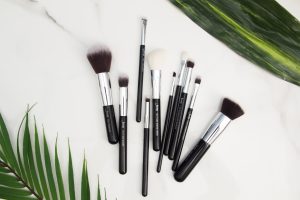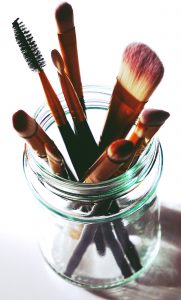The Quick and Easy Way to Clean Your Makeup Brushes

Your makeup brushes are your keys to creating beautiful looks. A high-quality set of brushes will last longer and stay bacteria-free if you take care of them properly.
If you’re still on the hunt for the perfect makeup brushes, we can help. We’ll go over what to look for in a makeup brush, must-have brushes, and how to keep them as clean as new.
What Are the Best Types of Brushes?
When searching for a makeup brush, there are two main qualities to look for:
- Never believe that a natural fiber brush is better than a synthetic one; many natural fiber brushes are made with animal hair, which is never an option if you’re against animal cruelty.
Furthermore, synthetic fiber brushes have undergone cutting-edge development, don’t wear down as quickly as natural fibers, and can be cleaned multiple times without deteriorating.
- A brush isn’t effective unless it is designed to work with the consistency of your cosmetics. Brushes must be able to apply your favorite products evenly and smoothly to your skin, working together with the makeup you wear to create a natural look.
This foundation brush was designed with an angled head so that your foundation can be applied without the use of a mirror
Why Should I Clean My Makeup Brushes Regularly?

In order to maintain your brushes so that they last longer, you need to clean them on a regular basis. Here are the two most important reasons why:
Results
If you want your makeup brushes to work correctly, you need to clean them regularly.
When the fibers of your brush become clogged with product, dirt, and oils from your skin, they can start to stick together. This makes it difficult for you to get the desired effect from using your brushes.
Not only are dirty brushes unhygienic, but they also cause you to waste product. The dirt, oil, and residual makeup left on brushes can act like magnets and stick fresh product to the brush instead of transferring it to your skin during application.
This means using more product than necessary to achieve the desired results.
Bacteria
If you don’t clean your makeup brushes regularly, they can become a breeding ground for bacteria.
Transferring bacteria from your skin to your brush’s bristles is easy to do, and if you’re storing your brushes in a dark or moist place, the chances of them becoming contaminated are even higher.
A study from 2019 reported high levels of bacteria on both makeup products and brushes. If you use these dirty items, you’re more likely to get breakouts, rashes, or even dangerous infections like E. coli or staph.
When Should I Clean My Brushes?
There’s no need to clean your makeup brushes every day. In fact, the American Academy of Dermatology suggests a weekly cleaning routine for your brushes, every 7 to 10 days.
By keeping up with this regimen, you’re actually doing your skin a favor by ridding it of any harmful bacteria that might be hiding in your bristles and maintaining peak brush performance for future uses.
How to Keep Your Makeup Brushes Fresh
You don’t need a special brush cleanser to clean your makeup brushes; you can use items around your house. If you prefer, though, feel free to purchase one. Here’s how to quickly and easily clean your makeup brushes in four steps:
1. Rinse
To clean your makeup brushes, start by rinsing them under lukewarm water to loosen excess makeup. Avoid using hot water; it can damage the fibers of your brush, and it isn’t necessary to get the brush clean.
Once the excess makeup has lifted, it’s time to clea pro tip: avoid submerging the entire brush head under water. The water can loosen the glue that holds fibers in place.
2. Cleanse
You don’t need to waste your money on a specific soap for cleaning brushes—a run-of-the-mill dish detergent will suffice and be more gentle on bristles.
If you’re out of brush-cleaning solution and in a pinch, you can use Dawn dish soap. Be sure to rinse your brush immediately afterward, though; Dish soaps are created with ingredients that strip waxes and oils from surfaces, making them ideal for cleaning makeup brushes.
Never use your face wash to clean your makeup brushes! Not only would it be a terrible waste of product, but face washes aren’t designed to deep clean or get into the bristles like brush cleaners are.
Face cleansers are specifically designed to (sometimes barely) remove dirt and oil from your skin; they’re not meant for cleaning tough buildup on brushes.
Gently swirl and massage the fibers of your brush when cleaning it; scrubbing can damage the bristles and cause them to fall out.
3. Rinse
Repeat the process of washing and rinsing your brush with mild soap and room temperature water until it is entirely clean.
If you haven’t cleaned your brushes in a while, this may need to be done multiple times.
If you’re going to use a mild dish soap, make sure you rinse it completely. Many gentle cleaners can leave behind a residue, and if your brushes are coated in this residue, it will eventually end up on your face.
4. Dry
The best way to dry your brushes is by lightly squeezing out the wetness with a paper towel or microfiber cloth. You want to avoid using anything that could make the brush collect lint, such as a hand towel.
Once lint gets on the brush, it’s very difficult to remove and will most likely end up stuck in makeup product, which then transfers onto your skin.
Lay your brushes horizontally to dry. If you flip them halfway, it’ll speed up the process, but if you forget, it’s not a big deal.
A tip: Never let your brushes stand upright to dry; the water left in the bristles will drip down into the brush handle and weaken the glue holding everything together. Eventually, this causes falling-apart brushing.
Convenient Ways to Quickly Clean Your Brush
When you figure out a routine for cleaning your makeup brushes, you’ll discover it doesn’t take much time to keep them in good condition.
However, if you don’t have much time or are trying to remove a tough stain, there are some shortcuts you can attempt.
Effective Cleanse
If the thought of using a dirty makeup brush against your skin makes you cringe, try using a makeup remover wipe.
These are excellent for removing product and providing a gentle cleanse without taking up too much time.
Stains
Even after you clean your makeup brushes multiple times, they may still hold onto pigment, especially if the color is particularly vibrant.
Although it is not always possible to remove all synthetic colors (mostly reds and purples), raw coconut cream does an excellent job.
Coconut oil pulls the color from the bristles efficiently. This coconut cream is great for this use!
After you’ve rubbed the brush fibers with coconut cream, rinse them off with a mild detergent or shampoo.
In Conclusion…
By investing in long-lasting, high-quality makeup brushes, you can improve your cosmetics game. Nevertheless, it’s crucial to remember that your brushes will only work as well as you treat them.
That means routinely washing them, not just to protect the bristles but also to prevent harmful bacteria from coming into contact with your skin.
By washing your brushes regularly, you protect both the quality of your brushes and the health of your skin.
Opt for a natural solvent like living raw coconut oil, which is gentle on brush bristles. Gently swirl the bristles in soapy water before rinsing to avoid damage.
Keep up this good maintenance routine, which will result in an effortlessly polished look!

